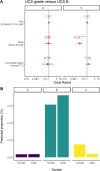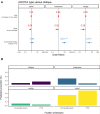Risk factors influencing fracture characteristics in postoperative periprosthetic femoral fractures around cemented stems in total hip arthroplasty : a multicentre observational cohort study on 584 fractures
- PMID: 34233455
- PMCID: PMC8325979
- DOI: 10.1302/2633-1462.27.BJO-2021-0027.R1
Risk factors influencing fracture characteristics in postoperative periprosthetic femoral fractures around cemented stems in total hip arthroplasty : a multicentre observational cohort study on 584 fractures
Abstract
Aims: This study evaluates risk factors influencing fracture characteristics for postoperative periprosthetic femoral fractures (PFFs) around cemented stems in total hip arthroplasty.
Methods: Data were collected for PFF patients admitted to eight UK centres between 25 May 2006 and 1 March 2020. Radiographs were assessed for Unified Classification System (UCS) grade and AO/OTA type. Statistical comparisons investigated relationships by age, gender, and stem fixation philosophy (polished taper-slip (PTS) vs composite beam (CB)). The effect of multiple variables was estimated using multinomial logistic regression to estimate odds ratios (ORs) with 95% confidence intervals (CIs). Surgical treatment (revision vs fixation) was compared by UCS grade and AO/OTA type.
Results: A total of 584 cases were included. Median age was 79.1 years (interquartile range 72.0 to 86.0), 312 (53.6%) patients were female, and 495 (85.1%) stems were PTS. The commonest UCS grade was type B1 (278, 47.6%). The most common AO/OTA type was spiral (352, 60.3%). Metaphyseal split fractures occurred only with PTS stems with an incidence of 10.1%. Male sex was associated with a five-fold reduction in odds of a type C fracture (OR 0.22 (95% CI 0.12 to 0.41); p < 0.001) compared to a type B fracture. CB stems were associated with significantly increased odds of transverse fracture (OR 9.51 (95% CI 3.72 to 24.34); p < 0.001) and wedge fracture (OR 3.72 (95% CI 1.16 to 11.95); p = 0.027) compared to PTS stems. Both UCS grade and AO/OTA type differed significantly (p < 0.001 and p = 0.001, respectively) between the revision and fixation groups but a similar proportion of B1 fractures underwent revision compared to fixation (45.3% vs 50.6%).
Conclusion: The commonest fracture types are B1 and spiral fractures. PTS stems are exclusively associated with metaphyseal split fractures, but their incidence is low. Males have lower odds of UCS grade C fractures compared to females. CB stems have higher odds of bending type fractures (transverse and wedge) compared to PTS stems. There is considerable variation in practice when treating B1 fractures around cemented stems. Cite this article: Bone Jt Open 2021;2(7):466-475.
Keywords: Cemented stem; Hip arthroplasty; Hip replacement; Periprosthetic fracture.
Figures


References
-
- No authors listed . National joint registry 17th annual report 2020. https://reports.njrcentre.org.uk/Portals/0/PDFdownloads/NJR%2017th%20Ann... (date last accessed 15th November 2020).
-
- Wroblewski BM, Siney PD, Fleming PA. Charnley low-frictional torque arthroplasty: follow-up for 30 to 40 years. J Bone Joint Surg Br. 2009;91-B(4):447–450. - PubMed
-
- Petheram TG, Whitehouse SL, Kazi HA, et al. . The Exeter universal cemented femoral stem at 20 to 25 years: a report of 382 hips. Bone Joint J. 2016;98-B(11):1441–1449. - PubMed
-
- Westerman RW, Whitehouse SL, Hubble MJW, Timperley AJ, Howell JR, Wilson MJ. The Exeter V40 cemented femoral component at a minimum 10-year follow-up. Bone Joint J. 2018;100-B(8):1002–1009. - PubMed

